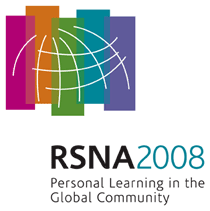
Abstract Archives of the RSNA, 2008
VS41-03
Evaluation of the Articular Cartilage of the Knee Joint at 3T Using Unspoiled Gradient Recalled-Echo Acquired in the Steady-State and IDEAL Fat-Water Separation (IDEAL-GRASS)
Scientific Papers
Presented on December 3, 2008
Presented as part of VS41: Musculoskeletal Series: Cartilage Imaging
 Research and Education Foundation Support
Research and Education Foundation Support
Richard Kijowski MD, Presenter: Nothing to Disclose
Donna Genette Blankenbaker MD, Abstract Co-Author: Nothing to Disclose
Michael Woods, Abstract Co-Author: Nothing to Disclose
Kazuhiko Shinki, Abstract Co-Author: Nothing to Disclose
Arthur August De Smet MD, Abstract Co-Author: Nothing to Disclose
Scott Brian Reeder MD, PhD, Abstract Co-Author: Spouse, Employee, General Electric Company
IDEAL is an SNR efficient fat-water separation method which can be combined with an unspoiled GRASS sequence to produce three-dimensional, high resolution images of the knee with bright synovial fluid at 3T. This study was performed to compare IDEAL-GRASS with a routine knee MRI protocol for evaluating the articular cartilage of the knee joint at 3T.
IDEAL-GRASS was added to the routine knee MRI protocol performed at 3T on 95 patients who underwent subsequent knee arthroscopy. All articular surfaces were graded at arthroscopy using the Noyes classification system. The MRI examinations were retrospectively and independently reviewed twice at separate sittings by 2 musculoskeletal radiologists. The radiologists used IDEAL-GRASS during the first review and the routine knee protocol during the second review to grade all articular surfaces using a modified Noyes classification system. Data from the 2 radiologists was combined for the statistical analysis. Using arthroscopy as the gold standard, the sensitivity, specificity, and accuracy of IDEAL-GRASS and the routine knee protocol for detecting cartilage lesions were determined. Nonweighted kappa statistic was used to measure interobserver agreement for determining the presence or absence of cartilage lesions. Weighted kappa statistic was used to measure the agreement between the cartilage grades assigned on MRI and at arthroscopy. Z tests were used to compare sensitivity, specificity, accuracy, and kappa values.
There was no statistically significant difference in the sensitivity, specificity, and accuracy of IDEAL-GRASS and the routine knee protocol for detecting 192 cartilage lesions within the knee joint (69%, 93%, and 85% respectively for IDEAL-GRASS and 66%, 93%, and 84% respectively for the routine knee protocol, p=0.34-0.83). There was no statistically significant difference (p=0.09-0.67) between IDEAL-GRASS and the routine knee protocol in kappa values measuring interobserver agreement and agreement between the cartilage grades assigned at MRI and at arthroscopy.
IDEAL-GRASS has similar diagnostic performance as a routine knee MRI protocol for evaluating the articular cartilage of the knee joint at 3.0T.
IDEAL-GRASS may be used to provide rapid cartilage assessment of the knee joint at 3T. The routine knee MRI protocol is effective at evaluating the articular cartilage of the knee joint at 3T.
Kijowski, R,
Blankenbaker, D,
Woods, M,
Shinki, K,
De Smet, A,
Reeder, S,
Evaluation of the Articular Cartilage of the Knee Joint at 3T Using Unspoiled Gradient Recalled-Echo Acquired in the Steady-State and IDEAL Fat-Water Separation (IDEAL-GRASS). Radiological Society of North America 2008 Scientific Assembly and Annual Meeting, February 18 - February 20, 2008 ,Chicago IL.
http://archive.rsna.org/2008/6012570.html


 Research and Education Foundation Support
Research and Education Foundation Support